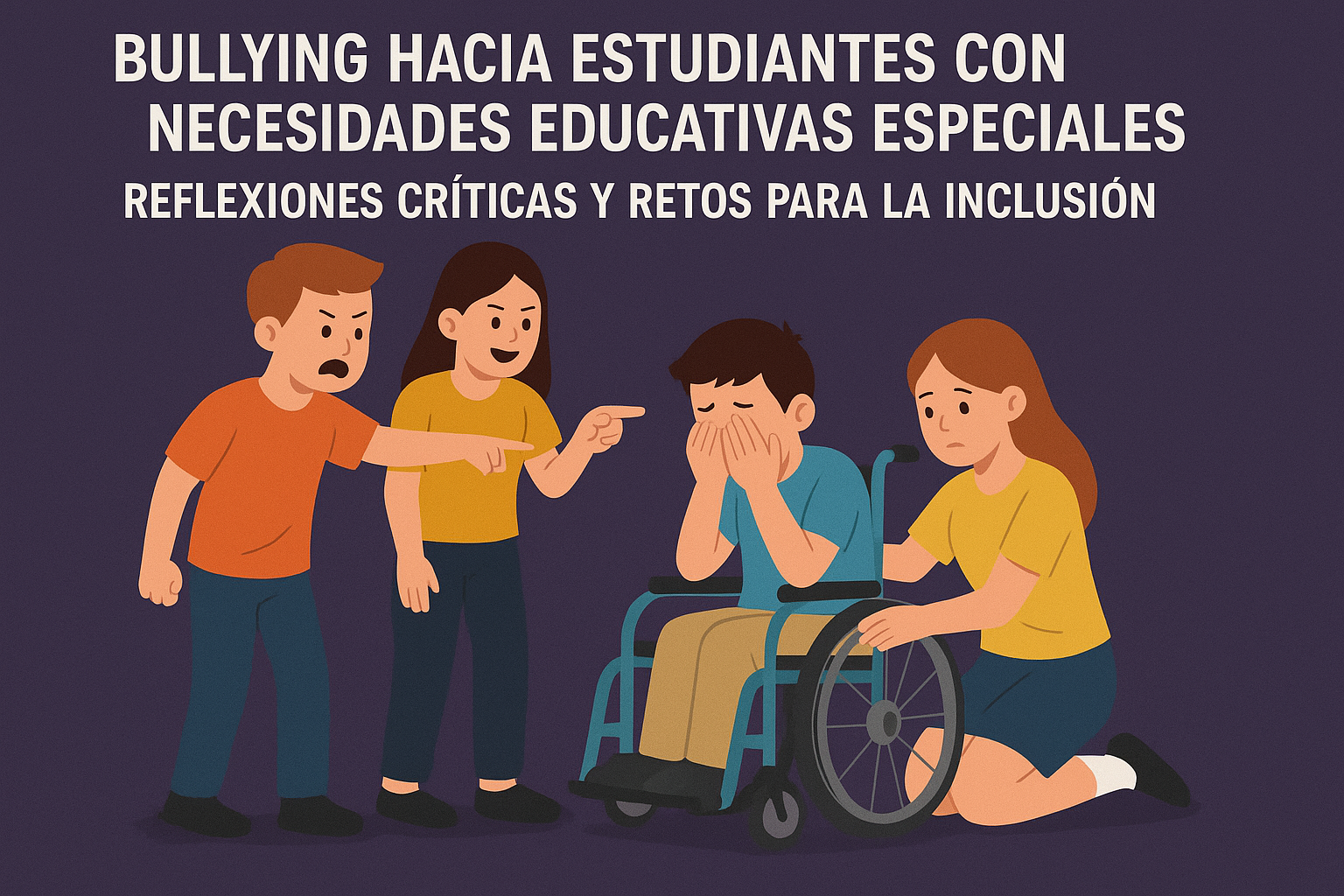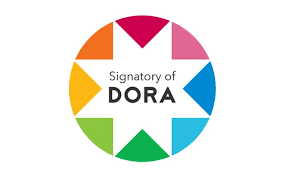Bullying hacia estudiantes con necesidades educativas especiales: reflexiones críticas y retos para la inclusión
DOI:
https://doi.org/10.56124/sapientiae.v8i18.004Palabras clave:
Bullying, discapacidad, Inclusión educativa, necesidades educativas especialesResumen
Este artículo analiza el bullying discriminatorio hacia estudiantes con necesidades educativas especiales y/o discapacidad como manifestación de capacitismo estructural. A partir de una revisión narrativa crítica de la literatura empírica internacional bajo el modelo socio-ecológico, se constata que: (a) la victimización entre este alumnado es de 1,5 a 4 veces mayor —y hasta 282 % superior cuando la discapacidad es el blanco explícito—; (b) el perfil víctima-agresor y los daños académicos, psicológicos y sociales resultan más severos y persistentes que en el acoso no discriminatorio; y (c) la pasividad de los espectadores consolida normas escolares que naturalizan la exclusión. El fenómeno se intensifica al confluir con otros ejes de estigma (género, etnia, orientación sexual, pobreza), demostrando que la vulnerabilidad proviene de desigualdades acumuladas y no de la diversidad funcional per se. Se concluye que las respuestas efectivas deben articularse en tres niveles simultáneos —estructural, interpersonal e intrapersonal— y que las políticas han de elaborarse con la participación directa del alumnado con NEE/D, para que la escuela transite de una lógica de gestión de “casos especiales” a un horizonte de justicia inclusiva.
Descargas
Citas
Ainscow, M. (2011). Responding to the challenge of equity within education systems. Aula: Revista de Pedagogía de la Universidad de Salamanca, 17, 73-87.
Ainscow, M., Slee, R., & Best, M. (2019). Editorial: the Salamanca Statement: 25 years on. International Journal of Inclusive Education, 23(7-8), 671-676. https://doi.org/10.1080/13603116.2019.1622800
Aljabri, A. S., Bagadood, N. H., & Sulaimani, M. F. (2023). Bullying of female students with intellectual disability in mainstream schools: Personal experiences from Saudi Arabia. International Journal of Educational Research Open, 5(September), 100287. https://doi.org/10.1016/j.ijedro.2023.100287
Álvarez-Marín, I., Pérez-Albéniz, A., Lucas-Molina, B., Martínez-Valderrey, V., & Fonseca-Pedrero, E. (2022). Development and Validation of a Brief Version of the European Bullying and Cyberbullying Intervention Project Questionnaires (EBIP-Q and ECIP-Q). Psicothema, 4(34), 571-581. https://doi.org/10.7334/psicothema2022.156
Álvarez, I., Pérez-Albéniz, A., Lucas-Molina, B., Martínez Valderrey, V., & Fonseca-Pedrero, E. (2022). Acoso escolar en la adolescencia: impacto en el ajuste socio-emocional y conductual. Revista de Psicodidáctica, 27(2), 141-148. https://doi.org/10.1016/j.psicod.2022.02.002
Amos, N., Hill, A. O., Lyons, A., Bigby, C., Carman, M., Parsons, M., & Bourne, A. (2023). Factors Associated With Experiences of Harassment or Abuse Among Lesbian, Gay, Bisexual, Trans, Queer, and Asexual Young People With Disability in Australia. Journal of Interpersonal Violence. https://doi.org/10.1177/08862605231216690
Arnaiz-Sánchez, P., De Haro-Rodríguez, R., Caballero, C. M., & Martínez-Abellán, R. (2023). Barriers to Educational Inclusion in Initial Teacher Training. Societies, 13(2), 31. https://doi.org/10.3390/soc13020031
Ball, L., Lieberman, L., Haibach-Beach, P., Perreault, M., & Tirone, K. (2022). Bullying in physical education of children and youth with visual impairments: A systematic review. British Journal of Visual Impairment, 40(3), 513-529. https://doi.org/10.1177/02646196211009927
Blake, J. J., Kim, E. S., Lund, E. M., Zhou, Q., Kwok, O. M., & Benz, M. R. (2016). Predictors of Bully Victimization in Students With Disabilities: A Longitudinal Examination Using a National Data Set. Journal of Disability Policy Studies, 26(4), 199-208. https://doi.org/10.1177/1044207314539012
Blake, J. J., Zhou, Q., Kwok, O.-M., & Benz, M. R. . (2016). Predictors of Bullying Behavior, Victimization, and Bully-Victim Risk Among High School Students With Disabilities. Remedial and Special Education, 37(5), 285-295. https://doi.org/10.1177/0741932516638860
Bronfenbrenner, U. (1979). La ecología del desarrollo humano: experimentos de la naturaleza y el diseño (MA: Harvar).
Chatzitheochari, S., Parsons, S., & Platt, L. (2016). Doubly Disadvantaged? Bullying Experiences among Disabled Children and Young People in England. Sociology, 50(4), 695-713. https://doi.org/10.1177/0038038515574813
Chávez, C., Cebotari, V., Benítez, M. J., Richardson, D., Hiu, C., & Zapata, J. (2021). School-related violence in Latin America and the Caribbean: Building an evidence base for stronger schools. Innocenti Working Papers, 1-68. https://doi.org/https://doi.org/10.18356/25206796-2021-02
Corbo, E., Palladino, B. E., & Menesini, E. (2021). Bullying and disability: A literature review about characteristics, consequences and prevention strategies . Psicologia Clinica dello Sviluppo, 25(2), 191-216. https://doi.org/10.1449/100101
Del Rey, R., Espino, E., Ojeda, M., & Mora‐Merchán, J. A. (2022). Bullying. En The Wiley‐Blackwell Handbook of Childhood Social Development (pp. 591-608). Wiley. https://doi.org/10.1002/9781119679028.ch32
Díaz-Faes, D. A., Codina, M., & Pereda, N. (2023). Experiences of Bias Victimization Among People With Intellectual Disabilities. Journal of Interpersonal Violence, 38(15-16), 9423-9437. https://doi.org/10.1177/08862605231165772
Donghi, E. (2016). Discriminatory bullying: Psychological well-being and victims’ social adjustment . Maltrattamento e Abuso all’Infanzia, 18(1), 9-28. https://doi.org/10.3280/mal2016-001002
Earnshaw, V. A. V. A., Reisner, S. L. S. L., Menino, D. D. D. D., Poteat, V. P. P., Bogart, L. M. L. M., Barnes, T. N. T. N., & Schuster, M. A. M. A. (2018). Stigma-based bullying interventions: A systematic review. Developmental Review, 48, 178-200. https://doi.org/10.1016/j.dr.2018.02.001
Echeita, G., & Ainscow, M. (2011). La educación inclusiva como derecho. Marco de referencia y pautas de acción para el desarrollo de una revolución pendiente. Tejuelo, 12(1988-8430), 26-46. https://repositorio.uam.es/bitstream/handle/10486/661330/educacion_echeita_TEJUELO_2011.pdf?sequence=1
Eilts, J., Rademacher, A., & Wilke, J. (2024). Bullying in adolescents : Co-occurrence of bullying roles and associations with special educational needs Bullying in adolescents : Co-occurrence of bullying roles and associations with special educational needs. Empirische Sonderpädagogik, December. https://doi.org/10.2440/003-0029
Eisenberg, M. E., Gower, A. L., Brown, C., Nam, Y. S., & Ramirez, M. R. (2022). School-Based Diversity Education Activities and Bias-Based Bullying Among Secondary School Students. Journal of Interpersonal Violence, 37(17-18), NP15992-NP16012. https://doi.org/10.1177/08862605211025016
Eisenberg, M. E., Lawrence, S. E., Eadeh, H.-M., Suresh, M., Rider, G. N., & Gower, A. L. (2024). Emotional Distress Disparities Across Multiple Intersecting Social Positions: The Role of Bias-Based Bullying. Pediatrics, 153(2). https://doi.org/10.1542/peds.2023-061647
Falla, D., & Ortega-Ruiz, R. (2019). Los Escolares Diagnosticados con Trastorno del Espectro Autista y Víctimas de Acoso Escolar: una Revisión Sistemática. Psicología Educativa, 25(2), 77-90. https://doi.org/10.5093/psed2019a6
Farmer, T. W., Petrin, R., Brooks, D. S., Hamm, J. V., Lambert, K., & Gravelle, M. (2012). Bullying Involvement and the School Adjustment of Rural Students With and Without Disabilities. Journal of Emotional and Behavioral Disorders, 20(1), 19-37. https://doi.org/10.1177/1063426610392039
Gage, N. A., Katsiyannis, A., Rose, C., & Adams, S. E. (2021). Disproportionate Bullying Victimization and Perpetration by Disability Status, Race, and Gender: A National Analysis. Advances in Neurodevelopmental Disorders, 5(3), 256-268. https://doi.org/10.1007/s41252-021-00200-2
Garaigordobil, M., & Machimbarrena, J. M. (2019). Victimization and Perpetration of Bullying/Cyberbullying: Connections with Emotional and Behavioral Problems and Childhood Stress. Psychosocial Intervention, 28(2), 67-73. https://doi.org/10.5093/pi2019a3
Graves, K. A., Mirielli, L. G., Ousley, C., & Rose, C. A. (2025). Literature Review and Content Analysis of Bullying Assessments: Are We Measuring What We Intend to? International Journal of Environmental Research and Public Health, 22(1), 29. https://doi.org/10.3390/ijerph22010029
Griffin, M. M., Fisher, M. H., Lane, L. A., & Morin, L. (2019). In Their Own Words: Perceptions and Experiences of Bullying Among Individuals With Intellectual and Developmental Disabilities. Intellectual and Developmental Disabilities, 57(1), 66-74. https://doi.org/10.1352/1934-9556-57.1.66
Gumpel, T. P., Zioni-Koren, V., & Bekerman, Z. (2014). An ethnographic study of participant roles in school bullying. Aggressive Behavior, 40(3), 214-228. https://doi.org/10.1002/ab.21515
Guzman‐Holst, C., & Bowes, L. (2021). Bullying and Internalizing Symptoms. En P. Smith & J. O’Higgins (Eds.), The Wiley Blackwell Handbook of Bullying (Firsr, pp. 560-579). Wiley. https://doi.org/10.1002/9781118482650.ch31
Haegele, J. A., Aigner, C., & Healy, S. (2021). Impact of weight and disability status on bullying victimisation and perpetration among youth. Journal of Paediatrics and Child Health, 57(3), 383-387. https://doi.org/10.1111/jpc.15230
Hartley, M. T., Bauman, S., Nixon, C. L., & Davis, S. (2015). Comparative Study of Bullying Victimization Among Students in General and Special Education. Exceptional Children, 81(2), 176-193. https://doi.org/10.1177/0014402914551741
Hebron, J., Oldfield, J., & Humphrey, N. (2017). Cumulative risk effects in the bullying of children and young people with autism spectrum conditions. Autism, 21(3), 291-300. https://doi.org/10.1177/1362361316636761
Herrera-López, M., Romera, E. M., Ortega-Ruiz, R., & Herrera, M. (2018). Bullying y Cyberbullying en Latinoamérica: un estudio bibliométrico. En Revista Mexicana de Investigación Educativa RMIE (Vol. 23, Número 76). Consejo Mexicano de Investigación Educativa. http://www.scielo.org.mx/scielo.php?script=sci_arttext&pid=S1405-66662018000100125&lng=es&nrm=iso
Hikmat, R., Yosep, I., Hernawaty, T., & Mardhiyah, A. (2024). A Scoping Review of Anti-Bullying Interventions: Reducing Traumatic Effect of Bullying Among Adolescents. Journal of Multidisciplinary Healthcare, Volume 17, 289-304. https://doi.org/10.2147/JMDH.S443841
Hong, J. S., & Espelage, D. L. (2012). A review of research on bullying and peer victimization in school: An ecological system analysis. Aggression and Violent Behavior, 17(4), 311-322. https://doi.org/10.1016/j.avb.2012.03.003
Hong, J. S., Lee, J. H., Rose, C. A., Marsack Topolewski, C. N., Daniels, D. E., & Grmusa, A. (2024). Bullying Involvement and Subtypes of Disabilities: Who is Likely to be Affected by What? Journal of Autism and Developmental Disorders, October. https://doi.org/10.1007/s10803-024-06547-4
Houchins, D. E., Oakes, W. P., & Johnson, Z. G. (2016). Bullying and Students With Disabilities: a Systematic Literature Review of Intervention Studies. Remedial and Special Education, 37(5), 259-273. https://doi.org/10.1177/0741932516648678
Juvonen, J., & Graham, S. (2014). Bullying in Schools: The Power of Bullies and the Plight of Victims. Annual Review of Psychology, 65(1), 159-185. https://doi.org/10.1146/annurev-psych-010213-115030
King, T., Aitken, Z., Milner, A., Emerson, E., Priest, N., Karahalios, A., Kavanagh, A., & Blakely, T. (2018). To what extent is the association between disability and mental health in adolescents mediated by bullying? A causal mediation analysis. International Journal of Epidemiology, 47(5), 1402-1413. https://doi.org/10.1093/ije/dyy154
Kowalski, R. M., Limber, S. P., & McCord, A. (2019). A developmental approach to cyberbullying: Prevalence and protective factors. Aggression and Violent Behavior, 45(February 2018), 20-32. https://doi.org/10.1016/j.avb.2018.02.009
Lawrence, S. E., Watson, R. J., Eadeh, H. M., Brown, C., Puhl, R. M., & Eisenberg, M. E. (2023). Bias-based bullying, self-esteem, queer identity pride, and disordered eating behaviors among sexually and gender diverse adolescents. International Journal of Eating Disorders, May 2023, 303-315. https://doi.org/10.1002/eat.24092
Link, B. G., & Phelan, J. C. (2001). Conceptualizing Stigma. Annual Review of Sociology, 27(1), 363-385. https://doi.org/10.1146/annurev.soc.27.1.363
Llauradó, E. V., & Estévez, A. L. (2024). Bullying and intellectual disability from the perspective of students. Journal of Intellectual Disabilities, 28(2), 315-325. https://doi.org/10.1177/17446295231154109
Llorent, V. J., Seade‐Mejía, C., Vélez‐Calvo, X., & Nasaescu, E. (2024). The Impact of Lockdown in Cyberbullying in Primary Education: Transitions of Cyberbullying and Bullying. Journal of School Health, 94(11), 1058-1068. https://doi.org/10.1111/josh.13505
Luque, D. (2009). Las necesidades educativas especiales como necesidades básicas. Una reflexión sobre la inclusión educativa. Revista Latinoamericana de Estudios Educativos (México), XXXIX(3-4), 201-223.
Malecki, C. K., Demaray, M. K., Smith, T. J., & Emmons, J. (2020). Disability, poverty, and other risk factors associated with involvement in bullying behaviors. Journal of School Psychology, 78, 115-132. https://doi.org/10.1016/j.jsp.2020.01.002
Martínez-Santiago, J., Zych, I., & Rodríguez-Hidalgo, A. J. (2023). Bullying personal y étnico-cultural en la Amazonía peruana: prevalencia, solapamiento y predictores. Revista de Psicodidáctica, 28(2), 153-163. https://doi.org/10.1016/j.psicod.2023.05.003
Menesini, E., & Salmivalli, C. (2017). Bullying in schools: the state of knowledge and effective interventions. Psychology, Health and Medicine, 22(sup1), 240-253. https://doi.org/10.1080/13548506.2017.1279740
Mitsopoulou, E., & Giovazolias, T. (2015). Aggression and Violent Behavior Personality traits , empathy and bullying behavior : A meta-analytic approach ☆. Aggression and Violent Behavior, 21, 61-72. https://doi.org/10.1016/j.avb.2015.01.007
Mulvey, K. L., Hoffman, A. J., Gönültaş, S., Hope, E. C., & Cooper, S. M. (2018). Understanding experiences with bullying and bias-based bullying: What matters and for whom? Psychology of Violence, 8(6), 702-711. https://doi.org/10.1037/vio0000206
Oldfield, J., Humphrey, N., & Hebron, J. (2017). Risk factors in the development of behaviour difficulties among students with special educational needs and disabilities: A multilevel analysis. British Journal of Educational Psychology, 87(2), 146-169. https://doi.org/10.1111/bjep.12141
Olweus, D. (1994). Bullying at School: Basic Facts and Effects of a School Based Intervention Program. Journal of Child Psychology and Psychiatry, 35(7), 1171-1190. https://doi.org/10.1111/j.1469-7610.1994.tb01229.x
Olweus, D. (1997). Bully/victim problems in school: facts and intervention. European Journal of psychology of Education, XlI, 495-510.
Olweus, D. (2013). School Bullying: Development and Some Important Challenges. Annual Review of Clinical Psychology, 9(1), 751-780. https://doi.org/10.1146/annurev-clinpsy-050212-185516
Ortega-Ruiz, R, Sánchez, V., & Menesini, E. (2002). Bullying and moral disengagement: A cross-national comparison,Volencia entre iguales y desconexión moral: Un análisis transcultural. En Psicothema. http://www.scopus.com/inward/record.url?eid=2-s2.0-0036341369&partnerID=MN8TOARS
Ortega-Ruiz, Rosario. (2002). Lo mejor y lo peor de las redes de iguales: juego, conflicto y violencia. Revista interuniversitaria de formación del profesorado, 44, 93-113. http://dialnet.unirioja.es/servlet/extart?codigo=249634%5Cnhttp://dialnet.unirioja.es/descarga/articulo/249634.pdf
Ortega-Ruiz, Rosario, Del-Rey-Alamillo, R., & Casas, J.-A. (2016). La Convivencia Escolar: clave en la predicción del Bullying. Revista Iberoamericana de Evaluación Educativa, 6(2), 91-102. https://revistas.uam.es/riee/article/view/3406
Pappas, G. (2023). School Bullying and Cultural Otherness: Vulnerable Social Groups and Education. Multidisciplinary Journal of School Education, 12(1 (23)). https://doi.org/10.35765/mjse.2023.1223.03
Paul, A., Gallot, C., Lelouche, C., Bouvard, M. P., & Amestoy, A. (2018). Victimisation in a French population of children and youths with autism spectrum disorder: A case control study. Child and Adolescent Psychiatry and Mental Health, 12(1), 1-13. https://doi.org/10.1186/s13034-018-0256-x
Pérez-Garín, D., Recio, P., Magallares, A., Molero, F., & García-Ael, C. (2018). Perceived Discrimination and Emotional Reactions in People with Different Types of Disabilities: A Qualitative Approach. The Spanish Journal of Psychology, 21, E12. https://doi.org/10.1017/sjp.2018.13
Puma-Maque, O. C., & Cárdenas-Zúñiga, M. del C. (2023). Bullying y cyberbullying en el contexto peruano (2017-2021): una revisión sistemática. Revista Latinoamericana de Ciencias Sociales, Niñez y Juventud, 22(1), 1-21. https://doi.org/10.11600/rlcsnj.22.1.6163
Pyżalski, J., & Smith, P. (2022). Nationality and ethnicity-based (cyber)bullying: how should we tackle this phenomenon in survey studies? Psychology, Society & Education, 14(3), 11-17. https://doi.org/10.21071/psye.v14i3.15285
Ratcliff, J. J., Lieberman, L., Miller, A. K., & Pace, B. (2017). Bullying as a Source of Posttraumatic Growth in Individuals with Visual Impairments. Journal of Developmental and Physical Disabilities, 29(2), 265-278. https://doi.org/10.1007/s10882-016-9523-z
Rodríguez-Hidalgo, Antonio;, Alcívar Pincay, A., Payán, A. M., Herrera-López, M., & Ortega-Ruiz, R. (2021). Los Predictores Psicosociales del Bullying Discriminatorio Debido al Estigma Ligado a las Necesidades Educativas Especiales (NEE) y la Discapacidad. Psicología Educativa, 27(2), 187-197. https://doi.org/10.5093/psed2020a22
Rodríguez-Hidalgo, Antonio, Alcívar, A., & Herrera-López, M. (2019). Traditional Bullying and Discriminatory Bullying Around Special Educational Needs: Psychometric Properties of Two Instruments to Measure It. International Journal of Environmental Research and Public Health, 16(1), 142. https://doi.org/10.3390/ijerph16010142
Rose, C. A., Espelage, D. L., & Monda-Amaya, L. E. (2009). Bullying and victimisation rates among students in general and special education: A comparative analysis. Educational Psychology, 29(7), 761-776. https://doi.org/10.1080/01443410903254864
Rose, C. A., & Gage, N. A. (2017). Exploring the Involvement of Bullying Among Students With Disabilities Over Time. Exceptional Children, 83(3), 298-314. https://doi.org/10.1177/0014402916667587
Rose, C. A., Simpson, C. G., & Preast, J. L. (2016). Exploring Psychosocial Predictors of Bullying Involvement for Students With Disabilities. Remedial and Special Education, 37(5), 308-317. https://doi.org/10.1177/0741932516629219
Rose, C. A., Stormont, M., Wang, Z., Simpson, C. G., Preast, J. L., & Green, A. L. (2015). Bullying and Students With Disabilities: Examination of Disability Status and Educational Placement. School Psychology Review, 44(4), 425-444. https://doi.org/10.17105/spr-15-0080.1
Ryoo, J. H., Wang, C., Swearer, S. M., & Park, S. (2017). Investigation of Transitions in Bullying/Victimization Statuses of Gifted and General Education Students. Exceptional Children, 83(4), 396-411. https://doi.org/10.1177/0014402917698500
Salmivalli, C. (2010). Bullying and the peer group: A review. Aggression and Violent Behavior, 15(2), 112-120. https://doi.org/10.1016/j.avb.2009.08.007
Salmivalli, C., Lagerspetz, K., Bjorkqvist, K., Österman, K., & Kaukiainen, A. (1996). Bullying as a Group Process: Participant Roles and Their Relations to Social Status Within the Group. Aggressive Behavior, 22, 1-15. https://doi.org/10.1002/(SICI)1098-2337(1996)22
Salmon, S., Turner, S., Taillieu, T., Fortier, J., & Afifi, T. O. (2018). Bullying victimization experiences among middle and high school adolescents: Traditional bullying, discriminatory harassment, and cybervictimization. Journal of Adolescence, 63(1), 29-40. https://doi.org/10.1016/j.adolescence.2017.12.005
Simpson, C. G., Rose, C. A., & Ellis, S. K. (2016). Gender Discrepancies and Victimization of Students With Disabilities. Remedial and Special Education, 37(5), 296-307. https://doi.org/10.1177/0741932516646082
Swearer, S., & Hymel, S. (2016). Bullying and Discrimination in Schools: Exploring Variations Across Student Subgroups. School Psychology Review, 44(4), 504-509. https://doi.org/10.17105/15-0133.1
Sweidan, A. T., El-Beialy, A. R., El-Mangoury, N. H., Mostafa, Y. A., & Dehis, H. M. (2024). Prevalence and factors influencing bullying among Egyptian schoolchildren. Journal of Orthodontics. https://doi.org/10.1177/14653125241229455
UNESCO. (2019). Compromiso de Cali sobre Equidad e Inclusión en la Educación. En Compromiso de Cali sobre Equidad e Inclusión en la Educación.
UNESCO. (2023). La inclusion de educandos con discapacidad en entornos de aprendizaje de calidad. Herramienta de apoyo a los países en su avance hacia la educación inclusiva. https://unesdoc.unesco.org/ark:/48223/pf0000380256_spa?posInSet=24&queryId=89524416-2325-4327-86dc-b95fffe435a0
Walters, G. D. (2020). Unraveling the Bidirectional Relationship Between Bullying Victimization and Perpetration: A Test of Mechanisms From Opportunity and General Strain Theories. Youth Violence and Juvenile Justice, 18(4), 395-411. https://doi.org/10.1177/1541204020922874
Warnock, M. (1987). Encuentro sobre necesidades de educación especial. En Revista de educación (Extra 1). https://dialnet.unirioja.es/servlet/articulo?codigo=18611
Wright, M. F. (2017). Cyber Victimization and Depression Among Adolescents With Intellectual Disabilities and Developmental Disorders: The Moderation of Perceived Social Support. Journal of Mental Health Research in Intellectual Disabilities, 10(2), 126-143. https://doi.org/10.1080/19315864.2016.1271486
Yang, D.-R., Tzeng, N.-S., & Lin, F.-G. (2022). Effect of Peer Victimization on the Long-Term Mental Health Status among Adults Users of Intellectual Disability Services: A Longitudinal Follow-Up Study. International Journal of Environmental Research and Public Health, 19(7), 4196. https://doi.org/10.3390

Publicado
Cómo citar
Número
Sección
Licencia
Derechos de autor 2025 Revista Científica Multidisciplinaria SAPIENTIAE. ISSN: 2600-6030

Esta obra está bajo una licencia internacional Creative Commons Atribución-NoComercial-CompartirIgual 4.0.

2.jpg)

















